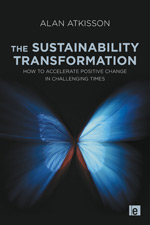This year, 2018, marks a decade since I first published The Sustainability Transformation* — the 2nd book in my planned 3-volume “Optimist Trilogy.” I’m now working on volume 3. But the “job description” from vol. 2 that appears on the first page of the first chapter is still highly relevant. Enjoy … and spread.
JOB DESCRIPTION
 World development is making most people richer and healthier. It is creating enormous new opportunities for human learning and self-expression. But it is also creating a dangerous set of conditions and trends – climate change, a stark rich/poor divide, an erosion of community and social capital, depletion of both non-renewable and renewable resources, conflict over resources, degraded ecosystems, disappearing species, and many other problems – that are increasingly likely to cause collapses and catastrophes, small and large. These growing dangers are greatly diminishing the long-term prospects of both people and nature. Our current course is not sustainable.
World development is making most people richer and healthier. It is creating enormous new opportunities for human learning and self-expression. But it is also creating a dangerous set of conditions and trends – climate change, a stark rich/poor divide, an erosion of community and social capital, depletion of both non-renewable and renewable resources, conflict over resources, degraded ecosystems, disappearing species, and many other problems – that are increasingly likely to cause collapses and catastrophes, small and large. These growing dangers are greatly diminishing the long-term prospects of both people and nature. Our current course is not sustainable.
Your job is to help change the world, by changing the systems in which you live and work. Your objective is to prevent collapse or catastrophe – in both human and natural systems – and to increase the prospects for a more sustainable and even beautiful future.
To assist you in accomplishing your assignment, you will be given access to current research about the trends shaping that future, as well as up-to-date news about important breakthroughs, tools, technologies and change processes. You will be linked up to other individuals and groups who have accepted the same job and who are spread out across the planet. This global ‘conspiracy of hope’, combined with the latest in communications technology, will make it possible to work in both physical and virtual teams, and to find help and support, almost anywhere.
Your prospects for success are better than they might appear, because slow changes can suddenly become very rapid, and because humanity has a long history of rising to overcome great challenges. But you face a number of daunting obstacles and limitations:
- You will be given minimal resources to pursue your mission – indeed, an extremely tiny amount when compared to the resources currently spent to fuel your community, company or government on its current course. You will have to find ways to create large-scale changes with small-scale budgets using high-leverage intervention strategies.
- You will be largely invisible to others, and it will sometimes be difficult to explain to other people what you are doing. Phrases like ‘sustainable development’, ‘global transformation’ or ‘a systems perspective’ still leave most people scratching their heads. You will have to communicate your intentions in ways that speak to people’s immediate and local needs while also convincing them to participate in longer-term, larger-scale changes to solve increasingly global problems. There is not enough time to wait for people to ‘wake up’ or ‘get it’ on a mass scale.
- You will have limited access to centres of power. If you achieve access, you will often discover that many people sitting in those centres of power feel surprisingly trapped by the system that they are supposedly controlling, and relatively powerless to make change. If you are not able to convince them otherwise, you will have to find other ‘leverage points’, other places to start change processes that can then spread through the system.
- Meanwhile, the momentum of change in the wrong direction will be immeasurably huge, and will probably continue to accelerate, in ways that seem unstoppable. It is imperative that you resist tendencies to despair and cynicism, in yourself and others, and that you find effective ways to spread a sense of hope and inspiration. For without hope – the belief that change is possible, that your vision of a sustainable world is attainable – your chances of success fall dramatically.
Good luck.
* The original title of The Sustainability Transformation was “The ISIS Agreement” (2008) — referring both to the Egyptian goddess, Isis, and to our planning methodology, which is introduced in the book (Indicators, Systems, Innovation, Strategy). The hardback version from 2008 is still available under the old name. We had to change the name of both the methodology and the book, for obvious reasons. The methodology is now called VISIS (we added “Vision”, because it was always part of the methodology anyway).